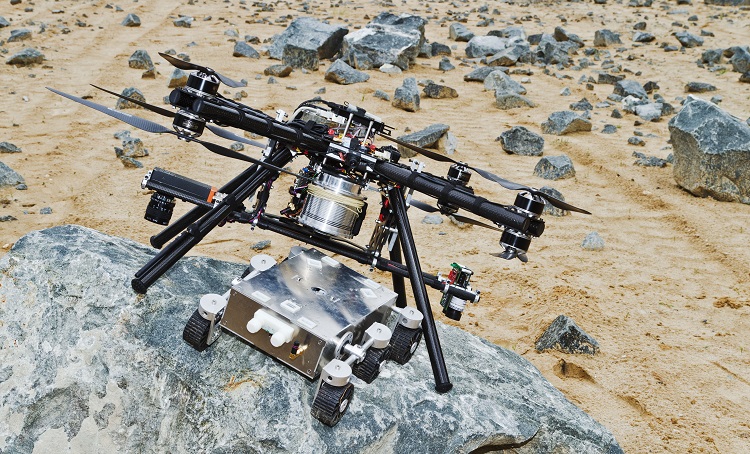These Quadcopter Dropships Could Land Rovers on Mars (Video)

An autonomous quadcopter could be landing space rovers on the Martian surface in future explorations of the Red Planet.
The European Space Agency's (ESA) "dropship" quadcopter steers itself, and can identify suitable areas to safely lower and land a rover onto the rocky surface of Mars. The so-called "Dropter" project is the latest development from ESA's StarTiger initiative, a program designed to bring together researchers from different fields to focus on one space exploration project at a time. ESA officials unveiled a video of the Dropter concept for Mars rovers this month.
Any unmanned rover lander headed for the Red Planet must be autonomous. With current technology, a human-controlled lander is impossible because of the communication lag between Mars and Earth. Researchers have already created landers that can precisely position rovers away from dangerous obstacles like clumps of rocks or steep slopes that can damage their delicate and expensive instruments. [Mars Explored: Landers and Rovers Since 1971 (Infographic)]
NASA, for example, used a huge "sky crane" to land the 1-ton Curiosity rover when it arrived on Mars in August 2012. After a parachute slowed Curiosity's descent, this autonomous structure took over. With rocket-powered thrusters to guide the landing, the sky crane lowered Curiosity down to the planet with cables. Then it cut the cords and flew safely off to the side for an intentional crash landing.
ESA has come up with a different approach. The Dropter team built the dropship lander to model a quadcopter — a helicopter with two propellers and four rotors. It uses GPS and inertia control to find its way to a predetermined suitable deployment zone. The dropship then switches to a vision-based navigation system, using lasers and barometers that can determine the safest spot to lower the rover down to the surface.
The Dropter dropship can reach a maximum height of 56 feet (17 meters), and once it identifies a safe spot, it descends to 33 feet (10 m) above the surface. Then the dropship lowers its precious cargo to the ground using a 16-foot (5 m) cable.
The team put the dropship through test flights in a 131-by-131-foot (40 by 40 m) model of the Mars landscape built at the Airbus Trauen site in Germany. For the tests, the dropship had to weave its way over huge rock patches and determine a safe landing spot to deliver the rover.
Get the Space.com Newsletter
Breaking space news, the latest updates on rocket launches, skywatching events and more!
The tests were successful, but the dropship is not ready for space yet. Researchers still need to test how it will perform carrying heavier, more realistic-size rovers, and figure out how the Martian atmosphere will influence the dropship's flying ability.
Follow Kelly Dickerson on Twitter. Follow us @Spacedotcom, Facebook or Google+. Originally published on Space.com.
Join our Space Forums to keep talking space on the latest missions, night sky and more! And if you have a news tip, correction or comment, let us know at: community@space.com.

Kelly Dickerson is a staff writer for Live Science and Space.com. She regularly writes about physics, astronomy and environmental issues, as well as general science topics. Kelly is working on a Master of Arts degree at the City University of New York Graduate School of Journalism, and has a Bachelor of Science degree and Bachelor of Arts degree from Berry College. Kelly was a competitive swimmer for 13 years, and dabbles in skimboarding and long-distance running.











